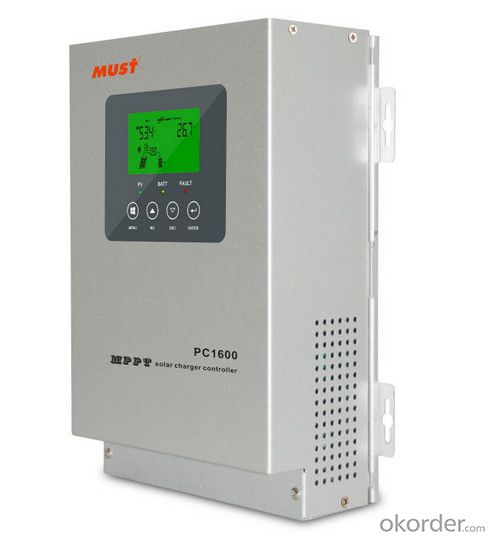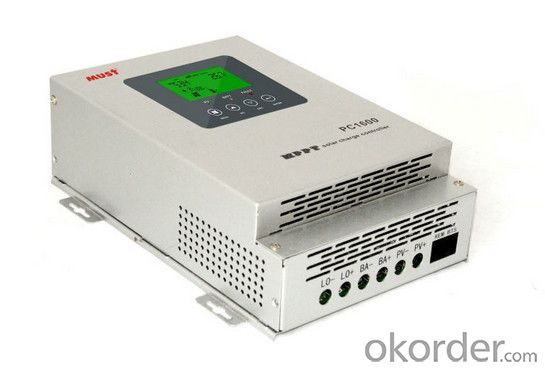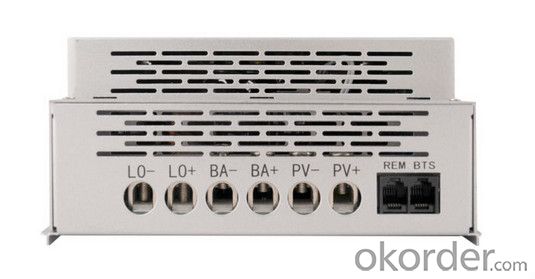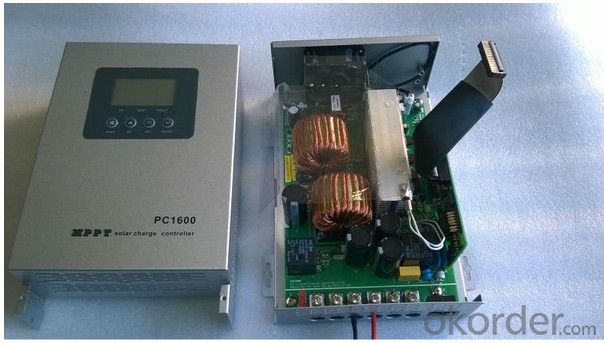MPPT Solar Charger Controller2015 Best Selling New Design PC1600F Series
- Loading Port:
- China main port
- Payment Terms:
- TT OR LC
- Min Order Qty:
- 1 pc
- Supply Capability:
- 1000 pc/month
OKorder Service Pledge
OKorder Financial Service
You Might Also Like
The Features of PC1600F MPPT Solar Charger Controller :
·45A/60A MPPT solar charge controller
·24V/48V auto work
·PV Output :70v-145v
·Several seconds tracking speed
·High Tracking efficiency of 99%
·Multiphase synchronous rectification technology
·Peak conversion efficiency of 98%
·DSP processors architecture ensures high speed and performance
·Multifunction LCD displays system data and status
·Four stages charging optimizes battery performance
The Specification of PC1600F MPPT Solar Charger Controller :
| odel | PC16-4515F | PC16-6015F |
| Default Battery system Voltage | 24v/48vdc(adjustable) | |
| Charge Input | ||
| PV Open Circuit Voltage range | Operational max=145VDC temperature correct VOC | |
| Max PV input power(24v) | 1200W | 1600W |
| Max PV input power(48v) | 2400W | 3200W |
| Battery voltage | ||
| Nominal Voltage | 24V / 48V | |
| Absorption Voltage | 27.0V / 54.0V | |
| Refloat Voltage | 27.4V / 54.8V | |
| Float Voltage | 28.6V / 57.2V | |
| Low voltage protection point | 21.0V / 42.0V | |
| DC Output | ||
| Output Voltage | 22.0-28.6V / 44V-57.2V | |
| Rated Current | 45A continuous @40°C ambient | 60A continuous @40°C ambient |
| Warning for low voltage | 23.0V / 46.0V | |
| Cut off for low voltage | 21.6V / 43.0V | |
| Low voltage recovery | 26.0V / 46.0V | |
| Display | ||
| LED indication | Systematic operation, LV indication, LV protection, over charge protection, loads protection, short circuit protection | |
| LCD display(optional) | Charge voltage, charge current, voltage of storage battery, capacity of storage battery, output current | |
| Alarm Protections | 1.PV array short circuit protection, PV reverse polarity protection 2.Battery reverse polarity protection , Over charging protection 3.Output short circuit protection 4.Low voltage protection for storage battery | |
| General specification | ||
| Protection Level | In compliance with regulations of DIN EN60529 and standards of IP22 | |
| Charge mode | PWM ,constant current—constant voltage, function of automatic protection for storage battery | |
| Radiating mode | Fan cooling | |
| Working mode | General controller | |
| Efficiency | ≥98% | |
| Self -consumption | < 10mA | < 15mA |
| Environment | ||
| Environmental temperature | -10°C --55°C | |
| Ambient humidity | 0--90%,No condensation | |
| Altitude | ≤4500m | |
| Dimension | ||
| Unit size D*W*H(mm)/G.W(kg) | 257.1*167.6*82.9mm/3kg | |
| Package size D*W*H(mm)/G.W(kg) | 390*365*365mm(6pcs/carton)/19kg | |
Some Pictures of PC1600F MPPT Solar Charger Controller on display




Warrenty
provides a 1~3 year limited warranty (“Warranty”) against defects in materials and workmanship for its Uninterruptible power supply, Power inverter/chargers, Solar charge controllers, Battery Products (“Product”).
The term of this Warranty begins on the Product(s) initial purchase date, or the date of receipt of the Product(s) by the end user, whichever is later. This must be indicated on the invoice, bill of sale, and/or warranty registration card submitted to MUST-Solar. This Warranty applies to the original MUST-Solar Product purchaser, and is transferable only if the Product remains installed in the original use location.
FAQ
1. How do I decide which system is right for me ?
For protection from long outages, include a generator or solar panels in your Must solar system. Shorter outages can be handled by a battery-only system.
2. Where my system will be installed ?
Must solar systems are usually wall-mounted near a home's main electrical (circuit breaker) panel.
3. How do I install my system ?
A must solar backup inverter is connected to a home electric system , we will supply detailed installation manual and videos for our customers .
4. How fast will my system respond to a power outage ?
Must solar inverters typically transfer to battery power in less than 16 milliseconds (less than 1/50th of a second).
- Q:Can a solar inverter be controlled remotely?
- Yes, a solar inverter can be controlled remotely. With the help of advanced monitoring systems and communication technologies, users can remotely access and control their solar inverters. This allows for convenient monitoring of power generation, performance optimization, and troubleshooting from any location with internet connectivity.
- Q:Can a solar inverter be used with different types of tracking algorithms?
- Yes, a solar inverter can generally be used with different types of tracking algorithms. Solar inverters are designed to convert the direct current (DC) generated by solar panels into alternating current (AC) for use in homes or businesses. The tracking algorithms, such as single-axis or dual-axis tracking, are responsible for optimizing the output of solar panels by adjusting their tilt and orientation according to the sun's position. Solar inverters are typically compatible with various tracking algorithms, allowing flexibility in system design and maximizing energy generation.
- Q:What is the role of a solar inverter in a solar-powered electric fence?
- The role of a solar inverter in a solar-powered electric fence is to convert the direct current (DC) generated by the solar panels into alternating current (AC) that is used to power the electric fence system. The inverter ensures that the energy captured by the solar panels is transformed into a usable form for the electric fence, allowing it to function efficiently.
- Q:How does a solar inverter handle grid synchronization during startup?
- During startup, a solar inverter handles grid synchronization by first ensuring that the grid is stable and within acceptable voltage and frequency ranges. It then synchronizes its output voltage and frequency with the grid by monitoring its phase angle and adjusting it accordingly. This synchronization process allows the solar inverter to safely and seamlessly connect to the grid, ensuring smooth power transfer and operation.
- Q:What is the maximum power rating of a solar inverter?
- The maximum power rating of a solar inverter typically depends on the specific model and manufacturer. It can range from a few hundred watts for small residential inverters to several megawatts for large-scale commercial or utility-grade inverters.
- Q:How does a grid-tied solar inverter function?
- A grid-tied solar inverter functions by converting the DC (direct current) electricity generated by solar panels into AC (alternating current) electricity that can be used to power homes or businesses. It synchronizes the AC electricity produced by the solar panels with the utility grid, allowing excess energy to be fed back into the grid for credit or compensation. The inverter also ensures the safety of the grid by continuously monitoring the voltage and frequency of the electricity produced.
- Q:What is the maximum DC input current for a solar inverter?
- The maximum DC input current for a solar inverter can vary depending on the specific model and manufacturer. It typically ranges from 10 to 60 amps, but it is best to consult the product specifications or contact the manufacturer for the exact maximum DC input current of a particular solar inverter.
- Q:Can a solar inverter be used in systems with different module efficiencies?
- Yes, a solar inverter can be used in systems with different module efficiencies. The solar inverter is designed to convert the DC electricity produced by the solar modules into AC electricity that can be used in the electrical grid or to power appliances. It does not depend on the module efficiency, but rather on the DC voltage and current produced by the modules. Therefore, as long as the DC output of the modules falls within the specifications of the solar inverter, it can be used regardless of the module efficiencies.
- Q:How does a solar inverter affect the overall efficiency of a solar system?
- A solar inverter plays a crucial role in the overall efficiency of a solar system. It converts the direct current (DC) electricity generated by solar panels into alternating current (AC) electricity that can be used to power household appliances and feed into the grid. By efficiently converting and optimizing the electricity output, a solar inverter ensures minimal power losses and maximizes the system's overall efficiency.
- Q:Can a solar inverter be used with building-integrated photovoltaics (BIPV)?
- Yes, a solar inverter can be used with building-integrated photovoltaics (BIPV). The solar inverter is an essential component that converts the DC power generated by the BIPV system into AC power suitable for use in buildings. It ensures efficient utilization of the solar energy produced by the BIPV system and enables integration with the electrical grid or building's power system.
1. Manufacturer Overview |
|
|---|---|
| Location | |
| Year Established | |
| Annual Output Value | |
| Main Markets | |
| Company Certifications | |
2. Manufacturer Certificates |
|
|---|---|
| a) Certification Name | |
| Range | |
| Reference | |
| Validity Period | |
3. Manufacturer Capability |
|
|---|---|
| a)Trade Capacity | |
| Nearest Port | |
| Export Percentage | |
| No.of Employees in Trade Department | |
| Language Spoken: | |
| b)Factory Information | |
| Factory Size: | |
| No. of Production Lines | |
| Contract Manufacturing | |
| Product Price Range | |
Send your message to us
MPPT Solar Charger Controller2015 Best Selling New Design PC1600F Series
- Loading Port:
- China main port
- Payment Terms:
- TT OR LC
- Min Order Qty:
- 1 pc
- Supply Capability:
- 1000 pc/month
OKorder Service Pledge
OKorder Financial Service
Similar products
New products
Hot products
Hot Searches
Related keywords
































